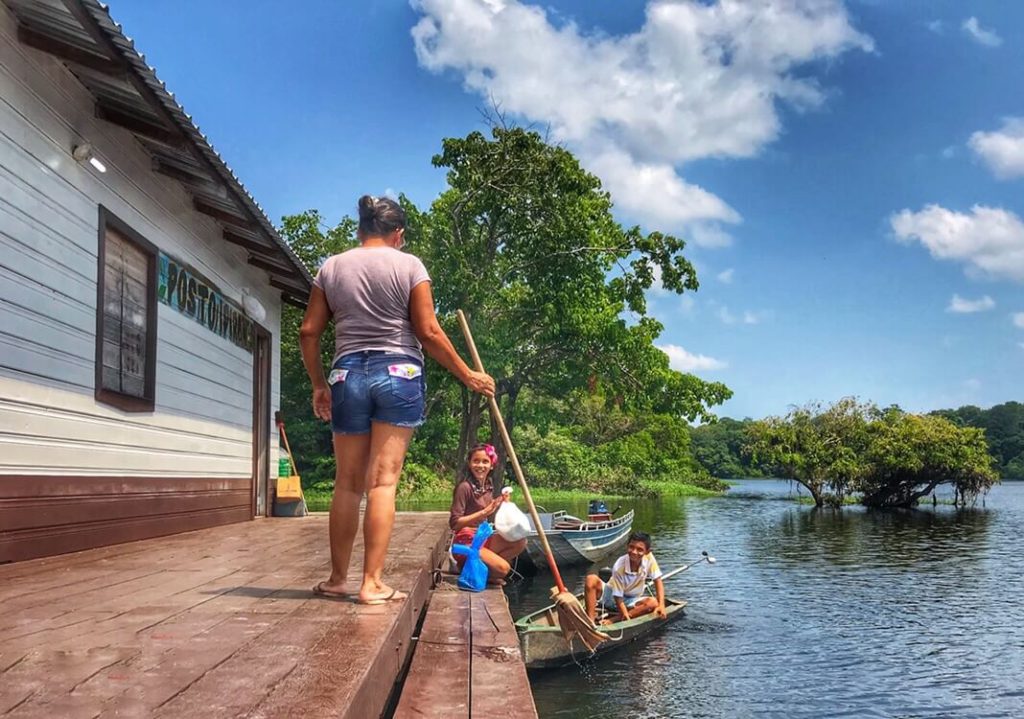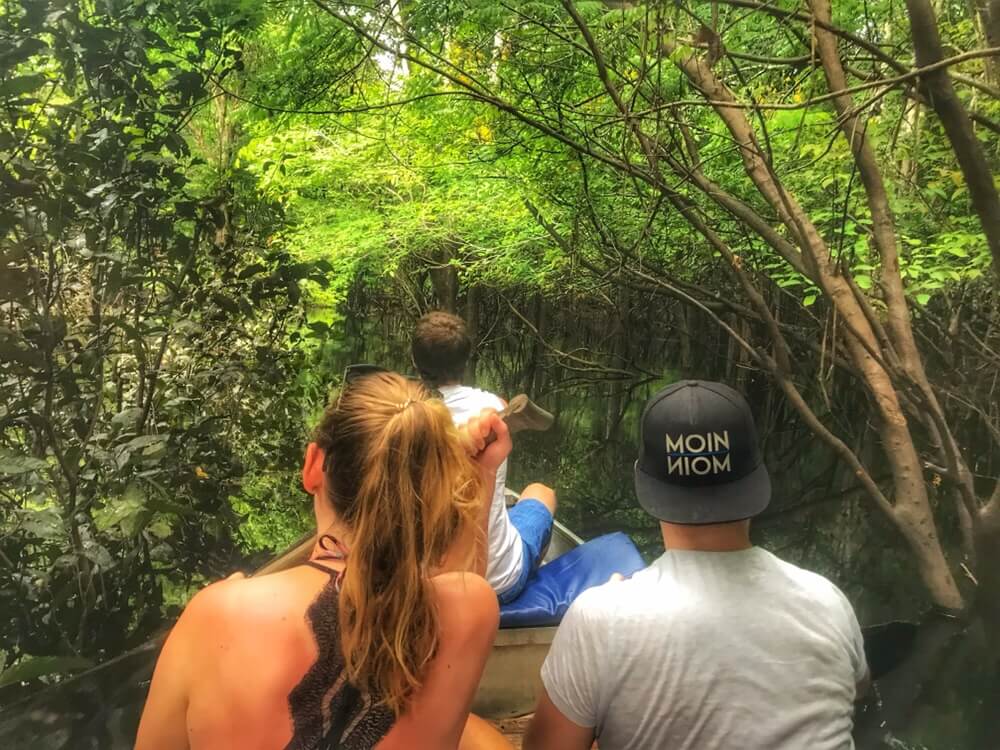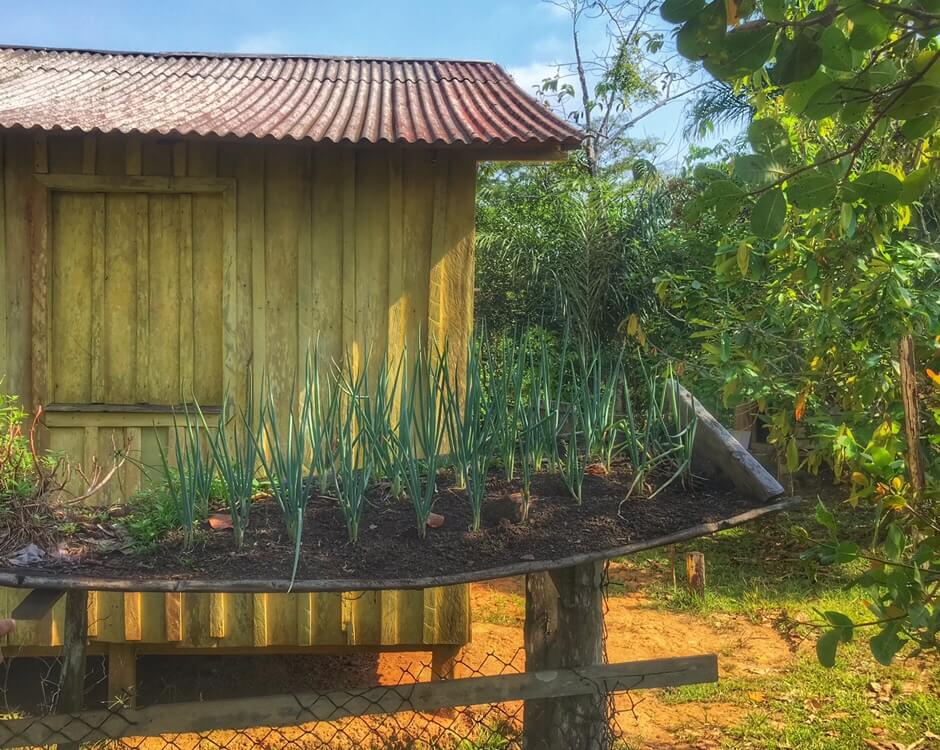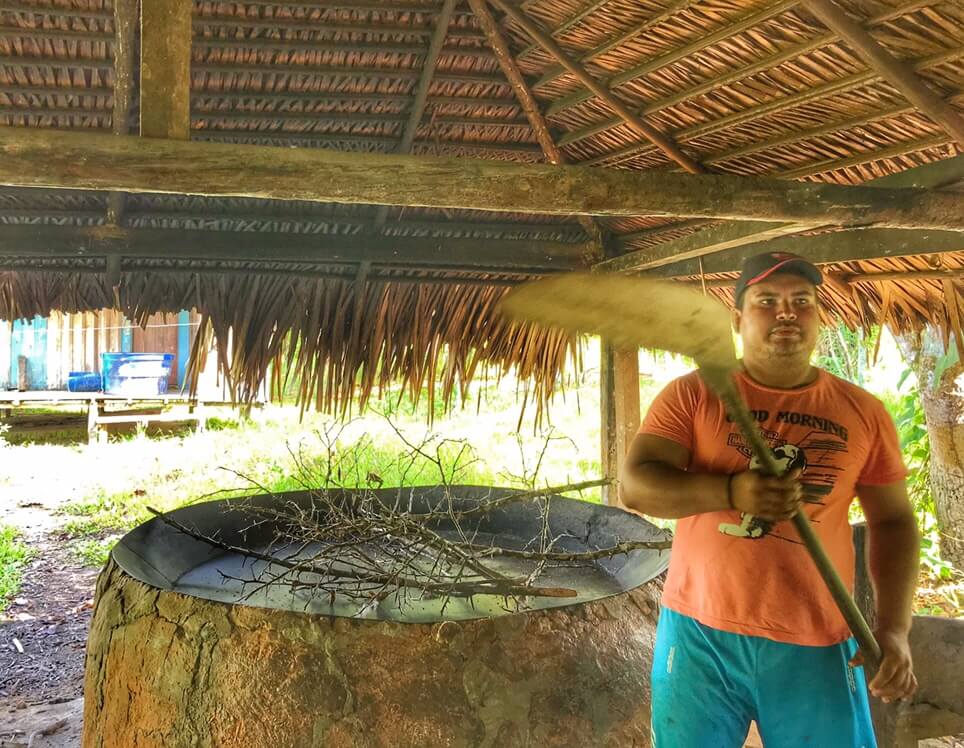Pink Dolphins may sound like a mythical creature but they indeed exist in freshwater rivers. Spotting pink dolphins was on my list of things to see while on our Amazon jungle tour. I had no interest in swimming with dolphins in captivity so I would take my chances and hope to see one in the wild.
They are a bit elusive. Many times during our excursions, we would see a splash in the water and we would wait eagerly to see a flash of pink, but it was only a red herring.
So far we had swum in waters where piranhas lived and crashed through the jungle when our machete-wielding guide yelled ‘run’ and now it is time to see or do those last few things we wanted to see in the Amazon region and say a few, sad goodbyes.
Tips on how to experience your Amazon jungle adventure is at the end of this post.
Could I Live in the Amazon?
In almost every place we have visited I ask myself, could I live here? Well, the simple answer is yes, technically I could live anywhere and find a way to make it work, but would I want to?
Alia, Lindsay, and I floated in the dark waters of the Rio Jamba a tributary to the Amazon river. It was a sunny day, hot and muggy. The water was warm but refreshing. We floated there talking about life back in the United States.

It was a relaxing afternoon. They played American music on the loudspeakers, like Bryan Adams, and a lot of Gun n Roses. Interestingly, they never played Welcome to the Jungle. Perhaps they have grown tired of it, and in defiance, they’ll never play that song even if you got down on your nanananana-knees.
Cacá had brought us all to a friend’s home via a boat crossing of the Lake Juma and through narrow water paths that he said disappear during the dry season. He brought us here to cook the Peacock Bass that he caught at sunrise. It is actually the local bar and general store, a hang out on a few massive logs that float in the water.
Cacá assured us that the water here was safe for swimming. Although when we asked what happened to his friend’s dog who had a crocked jaw and walked a little funny he told us that he was attacked by a caiman. So nothing to worry about, it’s not like a caiman can swim or anything.

Needless to say, we still enjoyed the afternoon while the fish grilled and beer flowed freely. I was having a hard time getting a sense of what life was really like here in the Amazon Jungle. We had seen glimpses, but I still had so many questions.
Pass the Machete, Please
Cacá shared some of the tranquil life of the Amazon during a sunrise boat excursion. We all got up around 5:30 AM to climb into the little aluminum boat and motor out to the middle of the lake. From there we would have a perfect vantage point to watch the sunrise.
While we sat there enjoying the light pastel colors changing in the sky Cacá was fishing from the back of the boat. He is an expert at landing his bait right at the tree line in the water behind us. Then he would reeled it in and we watched as the lure darted across the top of the water.
It didn’t take long before the line went taught and he began the fight of bringing in our dinner. We could tell that whatever was on the line was big. Since it never flew out of the water we didn’t know what he may have caught.
As the catch grew closer it suddenly stopped and the reel would no longer pull the fish closer.
“He has gone under a log,” Cacá said. Then he leaned down over the boat and reached into the water shoulder deep to fight the fish by hand. Since many fish that live in these waters have very large teeth we watched with concern.
He struggled a moment then with a great heft lifted a huge fish out of the water.

“Pass the machete please,” he asked while the fish wildly swung its tail back and forth. Three quick taps on the head with the backside of the machete and the fished ceased its struggle.
A lot of people pay for sports-fishing trips. Cacá gets to do this any day as part of his day-to-day life here, to pull dinner from the black waters before the sun even rises. Later in the week he would walk into the jungle with just a machete and build a complete trap while we watched. All the materials needed for the trap he found in the jungle.
Even the Experts Get Lost
On our last full day, Cacá took us and the three new guests for a ride through denser vegetation in a canoe. We each had a paddle and we silently canoed through the trees looking for wildlife.
It started out fine and tranquil and I enjoyed the sensation of gliding smoothly among the trees. This was, quite literally, canoeing through a jungle. But then the vegetation started to get thicker and thicker. We were having to duck from branches and brushing off leaves and spiders. It started to rain.

“Are we lost?” I turned around and asked Cacá.
“Yes,” he said nonchalantly.
I continued to row and figured we had enough water for the night. His family would find us soon as they had when he got lost before.
We stopped to listen to the jungle. All of us sat still as our eyes scanned for any movement around us. The water lay flat and unmoving like the glass of a 2-way mirror. I looked over the edge of the little aluminum boat and saw my own reflection. I imagined that deep below the surface of the black waters an anaconda might just be looking back at me.
We started again and after a number of turns we made it out to the main waterway.
“Were we really lost?” I asked Cacá again, not sure if I believed yet that we were.
“Yes, but I have good GPS,” he said pointing to his forehead.
Vibrant green grasses reach out from the bank under darker greens of all shades in the trees above. They reflect perfectly onto the smooth surface of the Río Juma.
The Avatar Tree
Part of understanding a culture is to understand what they revere, like the Kaypok tree, specifically the Ceiba Pentandra here in the Amazon Jungle. Some say this is the tree inspired The Tree of Souls in the Avitar movie. A tree given great reverence, a center for life.
One afternoon we stood beside a massive Kaypok tree, or rather, we kinda danced around swatting mosquitos. It had just rained and the vicious creatures seemed to be out in full force even biting through Trin’s shirt and my pants.

The trunk of this tree was massive and tall. These Kaypok trees can grow up to 100 feet tall. The canopy of leaves didn’t even start until it was far above the rest of the jungle.
Cacá began to tell us about this tree speaking with the most reverence I had heard from him.
“This tree with her height helps souls ascend to heaven. It also connects the worlds below to the world above. It is a good place to be buried,” he said.
A Sense of Home
It wasn’t until the morning that Cacá took us to another friend’s home that I started to get a sense of what it might be like to live here.
We pulled our boat up to the shore. A shy dog barked once and then sat there nervously as six strangers climbed out of the boat onto a small area cleared of vegetation. The dirt beneath our feet was hardpacked almost to clay. We walked past the dog and towards a small home with a flock of chickens of all sizes running around beside it.

Plastic tubs and various containers were planted with flowers and some medicinal plants. A few crops grew on top of a large slat of wood bowing from the weight.
This home was not alone. We walked a path towards the right where a few other homes sat. It was the first place we had been in the jungle where there were a few homes on land that could be walked to. A shed housed tools and various animals.

A green Cockatoo perched on a branch under the roof of one shed. Cacá said his friends found it in the water with a broken wing so they took it in and have been feeding it since then.
Cacá then leaned over and opened a box that revealed two pet boa constrictors. They were still very small. I asked him if we could hold them so he pulled one out of the box and held it up for me. It wrapped its smooth belly around my wrist and its tail where the colors of its scales seemed to darken rested on my palm.
In my other hand, I held the snake just behind the head to keep him from biting. They’re not poisonous but they have barbed teeth that I wanted to avoid.

Near the far end of the small cluster of homes lay a shed where manioc, known to us as cassava, was processed to produce farofa and tapioca. Farofa is a yellow powder served with most dishes here in Brazil. They sprinkle it on everything. The farofa is made by frying the manioc flour in animal fat.
I was most interested in the tapioca. Tapioca in Brazil is not what you may think of. It is not a pudding or the balls in a bubble tea. Manioc flour is the starch squeezed from the manioc plant and can be used to make crepe-like pancakes (which is also called tapioca, just to add to the confusion). Once we discovered tapioca I have been making them most mornings for breakfast with a fried egg. I’m truly going to miss the Brazilian tapioca when we move on to the next country.
It was here I felt a sense of “home”, of being in a neighborhood and having camaraderie. These homesteads in the clearing with their signs of daily life and routine gave me an idea of what it could be like to live here.
Do I love it here? Yes. Do I want to live here? No, not right now, I’m not ready to settle down yet. I don’t see us here in the future either when we do settle down, but I can definitely see the draw, the peace that Cacá mentioned when he talked about home.
Missing Home
It was just after getting this sense of home that we would say goodbye to our new friends from the USA. Trin and I were staying for another day and a half more. We all went to the store together where we would leave with Cacá in another boat while Alia, Jeffery, Lindsay, and Patrick would continue down the river with Cacá’s father back to Manaus.

The store mind you is about 250 sq feet and is also a floating home. It is the main hub. It is also the place where we took refuge just the other day when a thunderstorm came upon us. We did not want to be out in the middle of the water in a metal boat during a thunder and lightning storm. We waited on the porch under the overhang of the roof. The rain came down in a deluge and gray dolphins began jumping in the river in front of us.
On this day it was not raining but it felt dreary. We stood on the porch and waved goodbye. Three new guests were to come that night, but for the afternoon it would just be Trin and me with Cacá. Maybe it was the clouds, maybe it was the goodbye, maybe it was how much I miss all our friends in the USA but I felt a sense of longing as they pulled away.
We climbed into a smaller boat and began the journey back to our lodge. It was then that the elusive pink dolphins began to jump in front of us.
Travel Tips for Your Own Amazon Adventure
- Aside from Brazil, you can also enjoy an Amazon Jungle adventure in other countries like Ecuador, Colombia, and Peru. Consider this when you are planning your South America trip.
- Manaus, Brazil is a good jumping off point for your Amazon Jungle adventure. It has a good infrastructure to support the tourism, although the city itself does not offer much else by way of attractions aside from the theater and the market.

- Aside from an Amazon jungle tour, your adventure could be in a form of a river cruise, a sport-fishing trip, a kayaking tour, a deep-jungle expedition, or others.
- If you choose to launch your adventure from Manaus, there are many areas where you can go to: Rio Negro, Rio Juma, Rio Taruma Acu, Rio Mamori, and others. Consider that some areas like the Rio Negro and Rio Juma have a level of acidity to the water that makes it inhospitable for mosquito larvae, so there are fewer mosquitoes in those areas.
- There is a wide spectrum of accommodations from survival camping to luxury suites. Choose based on your comfort requirements and budget.
- There are tours that span from a half day to five days or more. Based on the tour itineraries that you can find online, you can probably hit the major attractions/activities in three days and include other minor attractions within five days. For any additional days, you will likely have repeat activities, or you could go to a different area, or go deeper into the jungle.

- Just to set expectations: You will see wildlife for sure, but you are not likely to see a gigantic anaconda or other creatures that have been sensationalized in the movies, except maybe if you go deeper into the jungle in a personalized tour.
Major Attractions
- To us, the major attractions were piranha fishing, caiman spotting, jungle hiking, wildlife viewing, and visiting a local family home. If you are a birder like Patrick, you will love the variety of bird species in the Amazon.
- Attractions that we don’t really care for (and skipped) were: swimming with dolphins – the experience looked artificial and it seemed all about getting the Instagram picture, watch videos on Youtube about it and you will see what I mean; visiting an indigenous tribe – the tribe folks put on their tribal garb and perform rituals and dances, and in the end the tourists get to join in. To me, it’s only mildly appealing. If you have a genuine interest in understanding their culture, then this brief exposure will probably not hold too much meaning.
- This being nature, the elements could throw a howler monkey wrench to your itinerary. Due to rain, we missed out on spear-fishing and a night jungle hike.
Carefully choose your agency
- There are many tour agencies to choose from and some of them have generic names such that it is hard to know if the online reviews you are reading is really about that company or another. This is also true with the names of the lodges. I suspect that this is intentionally done. You may think that you booked a chalet at Juma Eco-Lodge and the pictures that you found online looks great, but no, your are in Juma Pousada Lodge and that spider was not on the catalog.
- With all these parameters in play, how do you choose? Our recommendations are: do at least three days to be able to experience the main activities; choose basic accommodation over luxurious ones. You are, after all, wanting to experience the Amazon jungle and culture; Unless you are paying top dollar, your lodge and your guide will likely be whichever has room and whoever is available. You could be lucky and get exactly the lodge and guide you want, but it is not guaranteed.
- In the end, the experience is what you make it. And it helps if the people in your group are cool. We definitely had a great time. Don’t sweat it out too much. You’re going to the Amazon, it’s gonna be awesome!



I would still live in the USA. It is the best country in the world! There are places that I would like to visit but I know that I would never want to live there. Loved this blog that you wrote. I felt like I was on the boat with you. Thanks Bonnie!
I still love the USA and it has some of the most beautiful places as well. I have no idea where we will eventually settle, I’m having fun with that. 🙂
As always, fully enjoyed this blog and Pedro was especially impressed with Trin’s cameo at the end of the tapioca video! 😉
LOL, He tried to emulate the street vendors that sell it 🙂
We miss you Bonnie! We talk about you and Trin all the time. That moment pulling away from y’all at the store was a reflective moment for me too – about how our lives intersected for that brief but oh-so-memorable phase, and how lucky we were to have ended up there with you all!
Definitely life long memories for us. I hope that our paths continue to intersect.
Another great post Bonnie! Love this quote: Were we really lost?” I asked Cacá again, not sure if I believed yet that we were.
“Yes, but I have good GPS,” he said pointing to his forehead.
That is funny but true when you are out in nature a lot!
As for where we would like to live in the world? We don’t know, we are still shopping and may be for a long time! 🙂
Cheers!
Thanks! We really enjoyed getting to know Caca and having him as our guide 🙂 We don’t know either, having too much fun figuring it out!
Hi Bonnie
Such Great Stories.I felt I was right there with you.
I would love to experience the Avatar Trees and the Tapioca has me totally intrigued.
Can you tell me more about the pink dolphins. Were there many? Did they interact with you? Did they stay with you for long?
Such great experiences.
Very jealous :). Thankyou for sharing
SC
Hi Shaun,
Thanks, I’m so glad you enjoyed this. Trees are always one of my favorites as well. They are so cool.
The pink dolphins seemed very different from ocean dolphins that I’m used to seeing and actually interacting with. The Pink ones seem very shy and not as playful. We did not see any full breach. Primarily it was only the occasional too of the head coming up for air.
Pink dolphins can hold their breath for a very long time. Once a dolphin was spotted We would sit in the boat and stare for a very long time waiting for the next to breach. Only a couple times did they breach far enough for us to see their full upper backs.
As I did my research for this article I found that there is limited information about the dolphins. It seems that because of their shy nature and the black waters in which they swim researchers have a hard time even estimating how many live in the Amazon. They are not even sure why they are pink!
Thanks again,
Bonnie